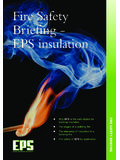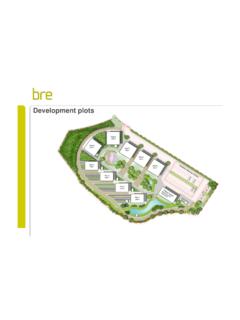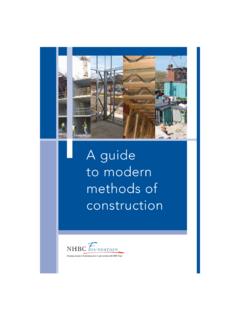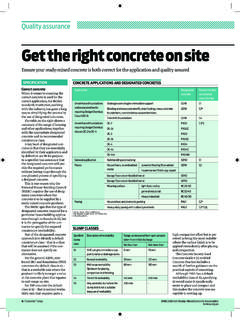Transcription of EPS Briefing
1 EPSB riefingFor Architects,ArchitecturalTechnicians,Buil ding andConstructionSpecifiersSPECIFIER BRIEFINGC over:Layout 1 26/01/2009 17:03 Page 1 EPS has for decades been the architect s number one choicefor economy, performance and sustainability in a wide range of applications. It is the leading 21st century solution for many construction and civil engineering tasks including: Roof, floor and wall insulation Sub-structures and void-fill blocks for civil engineering Foundation systems Clay Heave protection Bridge, rail and road widening schemes Underground heating system support Interior and exterior decorative mouldingsWe have designed this guide for ease of use in the busy specifier soffice. It is available in electronic (PDF) and printed versions. You can download copies from are four tabulated sections covering: Why specify EPS? - Attributes and applications What is EPS made of? - Production and composition How does EPS perform?
2 - Standards and performance What are EPS sustainability credentials?About this Specifier GuideCover:Layout 1 26/01/2009 17:03 Page 2 WhyspecifyEPS?Its attributes and applicationsATTRIBUTESD ividers:Layout 1 29/01/2009 17:19 Page 1 ITS ATTRIBUTES AND APPLICATIONSEPS may mean Expanded Polystyrene but it also stands for the three things which are crucial to modern construction - Economy, Performance and EPS offers a unique combination of attributes and advantages which has led toit being the leading choice for decades forarchitects and construction is ideally suited for the following applications: Roof, floor and wall insulation Sub-structures and void-fill blocks for civil engineering Foundation systems Clay Heave protection Bridge, rail and road widening schemes Underground heating system support Interior and exterior decorative mouldingsWhyspecifyEPS?11 Why? Pages:Layout 1 26/01/2009 09:52 Page 1 ITS ATTRIBUTES AND APPLICATIONSL ightweightEPS offers an exceptionally lightweight solution to so many applications in construction .
3 This is not surprising when you consider that, as a result of advanced manufacturing technologies, EPS is effectively98% air captured within a 2% cellular advantages in on-site handling and transportation bring significant economic benefits whilst considerably reducing health andsafety risks associated with the lifting of heaviermaterials. It is therefore an excellent substitutefor infill materials and ballast where it also bringsload and fill times down in time-critical Strength and Structural StabilityIn spite of its light weight, the unique matrixstructure of EPS brings the benefits of exceptional compressive strength and block-rigidity. This means it is ideal for use in many construction and civil engineering applications,particularly as a structural base infill, for examplein road, railway and bridge tests performed on EPS which was firstplaced in the ground almost 30 years ago showthat it is just as strong today the testedstrength routinely exceeding the originalWhyspecifyEPS?
4 21 Why? Pages:Layout 1 26/01/2009 09:52 Page 23 ITS ATTRIBUTES AND APPLICATIONS minimum design strength of bridge foundations, which have been subject to many years of sustained loading,show creep deformation of less that - only half as much as had been theoretically predicted. Most importantly, EPS stability doesnot deteriorate with is a well-established material forthe construction industry and offers aproven and economic solution whichhelps specifiers maintain build costsand insulation budgets. Far from incurring a cost premium, the new-build cost of insulating a building withEPS, rather than polyurethane, polyisocyanurate or mineral wool, istypically 20% less. Floor construction with EPSrequires only one waterproof membrane to beinstalled, not the two needed for mineral wool orPU foam saving on both material and for a given insulation performance, EPS itself costs less than these competing the construction sector, EPS has a long established reputation for its exceptionally high insulation qualities.
5 Its BRE A-plus rating means it is the perfect choice for use in under-floor, WhyspecifyEPS?31 Why? Pages:Layout 1 26/01/2009 09:52 Page 33 ITS ATTRIBUTES AND APPLICATIONS between-floor, walling and roofing applications where it is able to give a constant insulation value across the full service life of the conductivity testing of EPS to DIN52612, under the auspices of the Forschungsinstitut f r W rmeschutz in Munich,confirmed that its insulation efficiency was well within the originallyspecified standard requirement of those seeking higher performance materialfor the Code For Sustainable Homes (CSH), low lambda material is available which is typically grey in colour. The thickness of high-performance, low lambda EPS can be as little as 70mm, making possible a total floorthickness of Why? Pages:Layout 1 26/01/2009 09:52 Page 4 ITS ATTRIBUTES AND APPLICATIONSD esign VersatilityEase of cutting or moulding allows the factoryproduction or on-site preparation of complexshapes to match the most demanding architectural and design requirements usuallywithout the need for specialist cutting tools orskills.
6 This means the breathing masks, gogglesand protective gloves needed for working withmineral wool and other materials are not required with PerformanceEPS has a long and proven track record and hasbeen tested to some of the world s most demanding performance standards. EPS hasBBA Approval, BRE Certification and manywider industry accreditations. Its light weight,high compressive and impact strength, insulation, safety and eco-credentials combineto make it the preferred option for so many architectural and construction to Water IngressAfter almost 30 years in the ground, samples of EPS retrieved from locations as little as200mm above the groundwater level all have less than 1% water content by volume,WhyspecifyEPS?51 Why? Pages:Layout 1 26/01/2009 09:52 Page 5 WhyspecifyEPS?ITS ATTRIBUTES AND APPLICATIONS whilst blocks which are periodically entirely submerged show less than 4% water content performance notably superior to other foamed plastic in installation and useEPS is non-toxic, chemically inert, non-irritantand rot-proof.
7 Fungi and bacteria cannot growon EPS and it is insoluble and non-hygroscopic. EPS is also rodent-proof and offers no nutrientattraction to vermin. Nor is it affected by water,thus ensuring that moisture contact will not leadto deterioration of the product or its performance. In fact, the reinstatement of flood-damaged buildings is a much quicker, morepractical and less costly procedure if buildingstructures feature non-water-absorbing insulation material waterlogged open-cellfoams and mineral fibres are very vulnerable toflood damage, are very hard to dry out and maynever recover their insulation performance. Cement, lime, gypsum, anhydrite and mortarmodified by plastics dispersions have no effecton EPS, so it can confidently be used in conjunction with all conventional types of mortar, plaster and concrete encountered inbuilding construction . All of this makes it entirelysafe in use across all of its construction applications including subterranean and marine Why?
8 Pages:Layout 1 26/01/2009 09:52 Page 6 WhyspecifyEPS?ITS ATTRIBUTES AND APPLICATIONSS ustainability CredentialsAt every stage of its life cycle, from production to recovery or recycling, EPS offers exceptional eco-credentials and is therefore ideally suited to the new generation of eco-friendly building projects. All manufacturing processes comply with currentenvironmental regulation. EPS uses no greenhouse gas producing materials. It is chemically and environmentally non-aggressiveand it can be and is easily recycled into long-life products through an expanding nationwide network of collection Why? Pages:Layout 1 26/01/2009 09:53 Page 7 What isEPS made of ?Production andcompositionCOMPOSITIOND ividers:Layout 1 29/01/2009 17:19 Page 2 PRODUCTION AND COMPOSITIONWhat goes into EPS?Put simply, EPS is 98% air and 2% plastic. It uses, as its base material, styrene monomer. The monomer is a by-product of petroleum and naphtha produced during oil refining which provides a ready and continuous source.
9 Styrene also occurs naturally in many foods such as strawberries,coffee beans, beer and is produced when the styrenemonomer is polymerised into long chains. A gas called pentane is used as anon-CFC expansion agent to blow polystyrene into its final lightweight, expanded cellular form. During the production process, the pentane isquickly broken down into carbon dioxide and water. Pentane has lowvolatility. For example, it is found in thedigestive systems of animals and created when vegetable matter decomposes in a process called anaerobic composting. On the basis of current EU testing and classification regimes, styrene monomer is non-toxic in all normal usage and is not classifiedin terms of carcinogenicity or mutagenicity. Pentane has no potential to harm the ozone layer unlike CFCs or EPSmade of ?82 What? Pages:Layout 1 16/01/2009 11:45 Page 1 PRODUCTION AND COMPOSITIONWhat processes are used?
10 EPS has been made for more than half a century and EPS manufacturers complywith all current regulatory and legislative requirements. The processes include a combination of heat and pressure utilising clean technologies and minimising energy inputs and water usage through closed loop energy recycling. For all of these reasons, EPS manufacture is a highly efficient solid waste is created and process waste andoff-cuts are reintroduced to the productionbatch immediately. Atmospheric and land/water emissions are strictly controlled, resulting in minimal localised impacts. Where is EPS made?Due to the light weight of EPS and its relatively high volume, the EPS industryhas grown to be located close to its home markets. This means that, in theUK, a number of strategic production sites enable the construction sector to have a constant, close supply of EPS to meet their continuous EPSmade of ?92 What? Pages:Layout 1 16/01/2009 11:45 Page 2 PRODUCTION AND COMPOSITIONThis also means that architects and construction specifiers selecting EPS building solutions can be reassured that all EPS is supplied to exacting standards from a trustedsupplier.










